Types of whales: meet the largest animals in the ocean
Types of whales: meet the largest animals in the ocean
Whales are magnificent creatures. Not only are they highly intelligent, complex communicators, and the largest living animals on our planet, but they also protect us and the environment by providing the nutrients that help phytoplankton (tiny marine organisms that use photosynthesis) produce more than 50% of the world’s oxygen.
But, did you know that all species of whales are grouped into just two suborders? All whales are either baleen whales (mysticetes) or toothed whales (odontocetes). Baleen whales use fringed baleen plates to filter small prey from the water, while toothed whales use their teeth to hunt for prey.
Here are some different types of whales within these two groups, how to identify them, and what makes them so unique.
Mysticetes (baleen whales)
Humpback whale
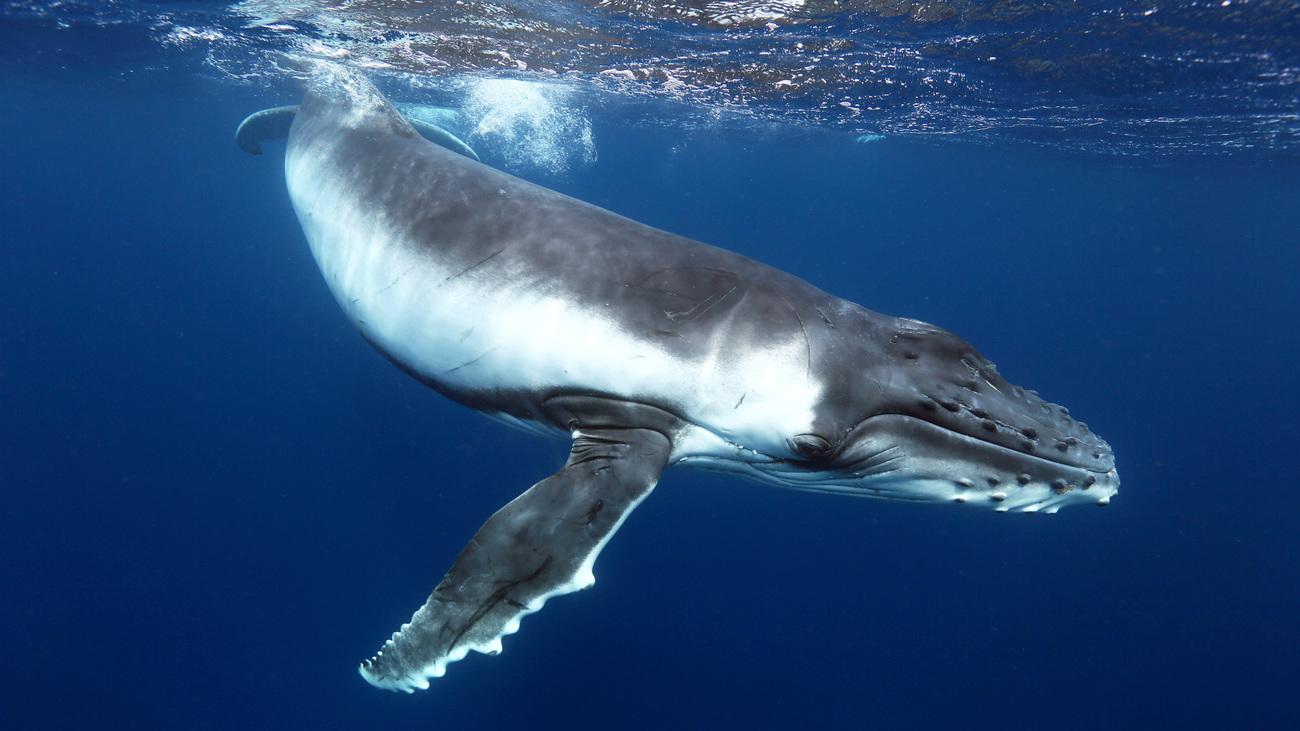
Acrobatic and charismatic, humpback whales (Megaptera novaeangliae) are one of the most well-known whale species and the stars of many whale watching tours. These baleen whales can grow to over 18 metres (59 feet) long and weigh over 36,000 kilograms (79,366 pounds).
Humpback whales are easily recognised by their long pectoral fins, which are the longest of any whale species, and are around one third of their body length. The humpback whale’s scientific name translates to ‘big-winged New Englander’. They also have an irregularly shaped dorsal fin and a hump that gives them their common name.
Knobby bumps on a humpback’s head are enlarged hair follicles called tubercles, which each contain at least one sensory hair. Their tails—called flukes—are unique to each individual, much like human fingerprints. Black and white patterns along with scarring on the underside of a humpback whale’s fluke help to identify it as an individual.
The humpback whale’s scientific name translates to ‘big-winged New Englander’. Despite their scientific name, they’re not just found in New England. Humpback whales are found in all major ocean basins around the world. They also migrate between warmer-water areas, where they mate and calve, and colder-water areas, where they feed.
Blue whales
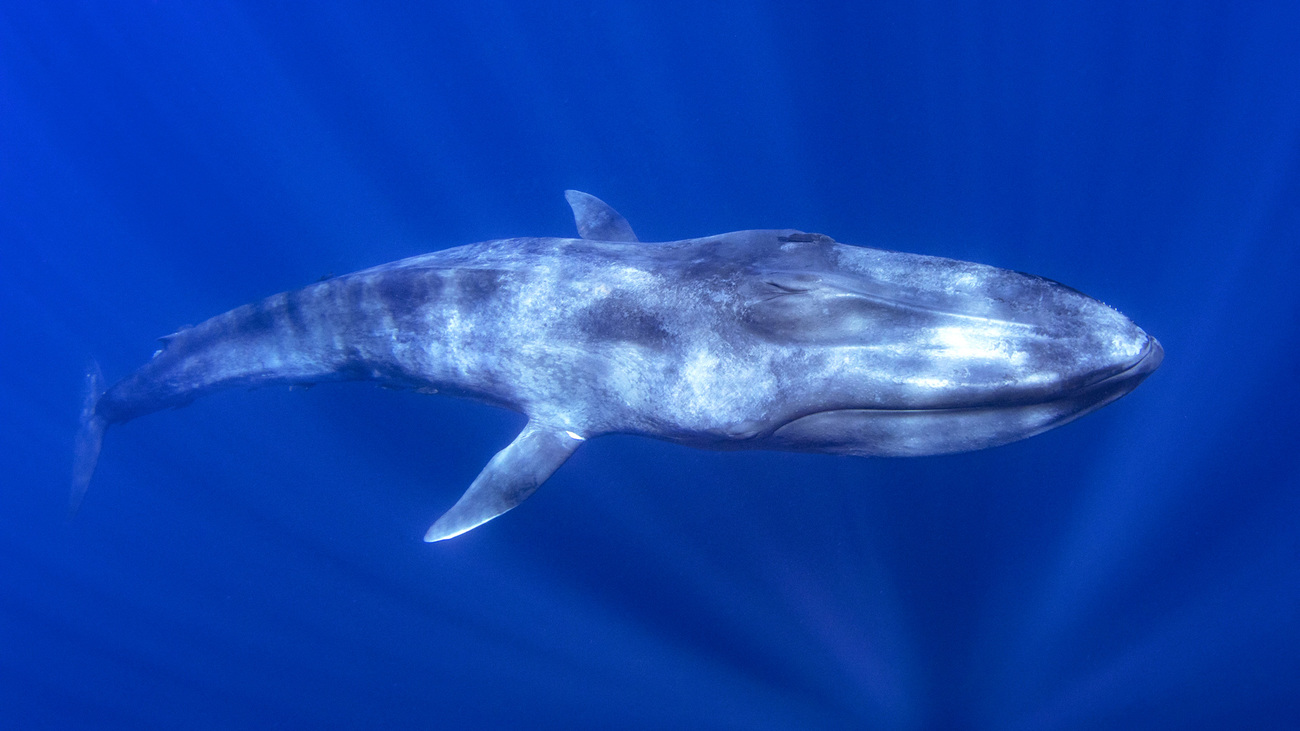
The blue whale (Balaenoptera musculus) is the largest animal on Earth. This baleen whale can grow up to 30 metres (100 feet) long and weigh as much as 180,000 kilograms (396,832 pounds)—their hearts alone weigh as much as a small piano! Blue whales are sleek and slender, and their streamlined, blue-grey bodies appear bright blue underwater, which gave them their name.
In addition to being the largest, blue whales are also the loudest animals on Earth. They can emit low-frequency vocalisations as loud as a jet plane, which are heard by other whales hundreds of miles away.
Right whales
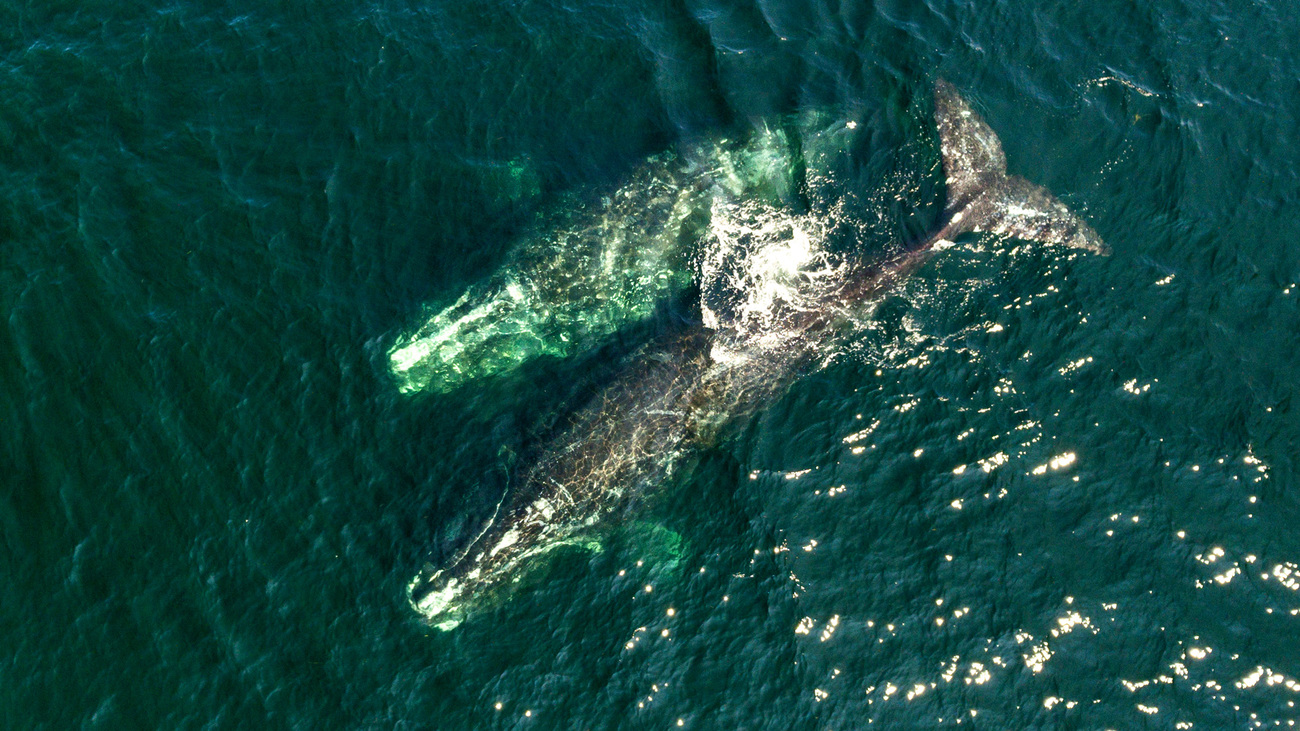
The right whale gets its name from the fact that whalers called it the ‘right’ whale to hunt due to its slow swimming speed and large amount of blubber, which was used for its oil. As a result, right whales have been hunted to near extinction. Commercial whaling has been banned since 1986 around the world, but the practice continues in a few countries using loopholes in regulations. Today, all populations of right whales are protected by law.
There are four species of right whale: the North Atlantic right whale (Eubalaena glacialis), North Pacific right whale (Eubalaena japonica), Southern right whale (Eubalaena australis), and bowhead whale (Balaena mysticetus).
The North Atlantic right whale is one of the most endangered species of whales in the world. As of 2025, there are only about 370 remaining. IFAW is leading efforts to protect this critically endangered species from the dangers of entanglement in fishing gear, underwater noise pollution, and vessel strikes.
Right whales can grow up to 15.8 metres (50 feet) long and weigh up to 63,500 kilograms (140,000 pounds). They have stocky, black bodies with white patches on their undersides. They lack a dorsal fin and have paddle-like pectoral flippers along with broad, smooth-edged flukes that help propel their massive bodies.
One of the most distinct features of right whales is their huge heads, which have roughened white patches called callosities. These are covered in whale lice, called cyamids. Each individual right whale has its own unique pattern of callosities, making them a perfect way for researchers to identify individuals.
Another distinctive characteristic of a right whale is the V-shaped blow or spout produced when it takes a breath.
Fin whales
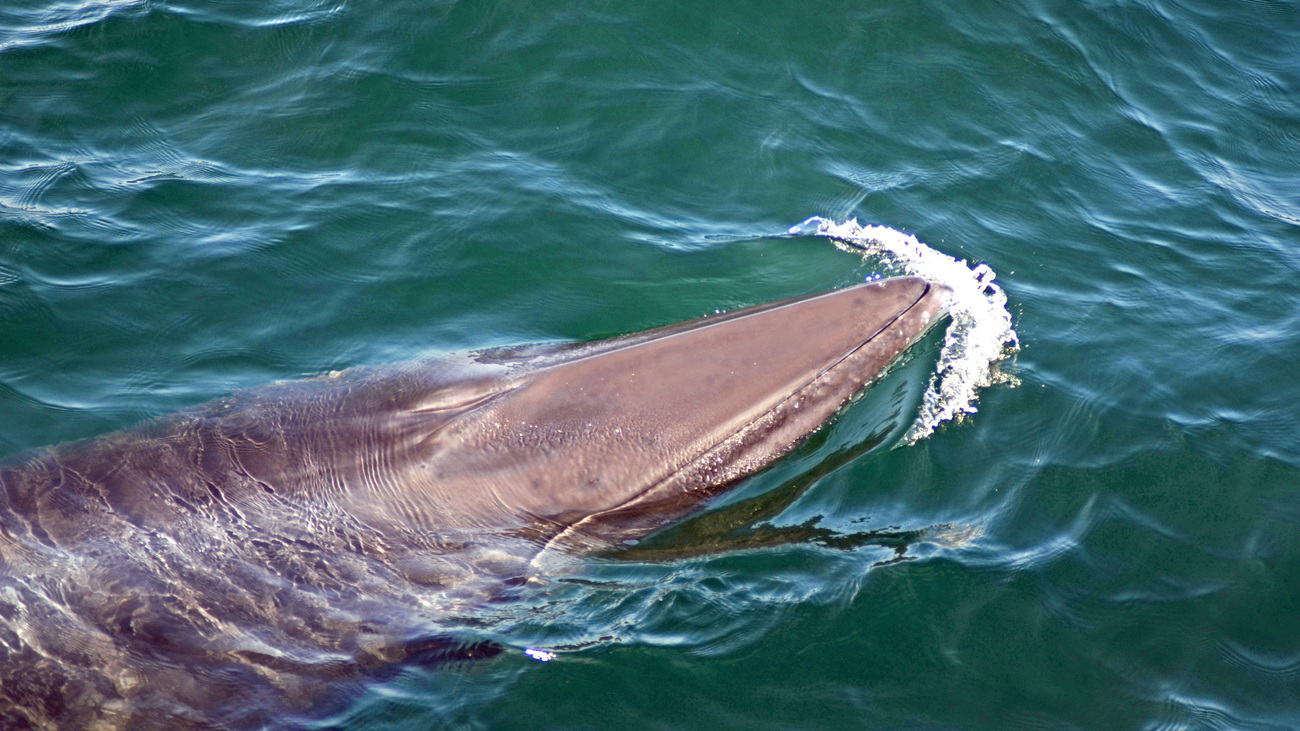
The second largest animal on Earth, next to the blue whale, is the fin whale (Balaenoptera physalus), also known as the finback whale. Named for its prominent dorsal fin, which is two-thirds of the way back on its body, the fin whale can grow up to 26 metres (85 feet) long and weigh up to 45,000 kilograms (99,000 pounds).
One of the fastest-swimming whales, fin whales are nicknamed the ‘greyhounds of the sea’. Fin whales belong to the rorqual family—a group of whales that also includes blue whales and humpbacks—which means they have pleats or grooves around their throat that expand to take in massive amounts of water and prey. This is the perfect adaptation to grow to massive sizes!
Fin whales have streamlined grey bodies with irregular white patches called chevrons that begin behind their blowholes and continue down onto their sides. They also have asymmetrical colouration—the lower right of their jaw is white, while the rest of their jaw is grey. It’s thought that this asymmetry helps them corral prey while they are hunting.
In Iceland, fin whales sadly continue to be hunted. Partnered with IceWhale, IFAW created the Meet Us, Don’t Eat Us campaign in Iceland to gain support for sustainable whale watching instead of commercial whaling and consumption.
Other baleen whales include minke whales, grey whales, sei whales, Bryde’s whales, Rice’s whales, Omura’s whales, and pygmy right whales.
Odontocetes (toothed whales)
Toothed whales tend to be smaller and more agile than baleen whales. While baleen whales eat tiny organisms like krill and zooplankton, toothed whales feed on larger animals like fish, squid, and other marine animals.
There are 77 species of toothed whales, including some of the most well-known whale species like sperm whales and orcas. Toothed whales vary in size and can be found in different oceans and seas around the world.
Here are some different types of toothed whales.
Sperm whales
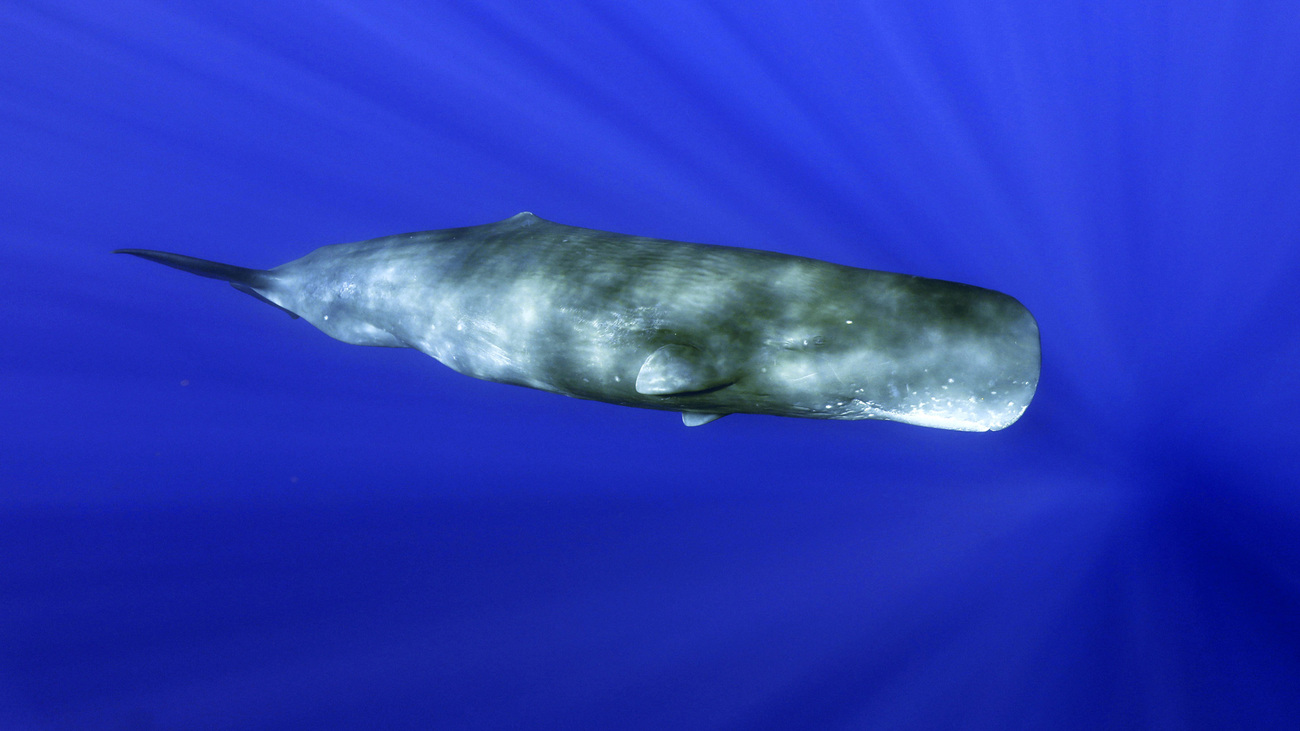
Sperm whales (Physeter macrocephalus) are the largest toothed whales, making them the world’s largest toothed predators. Growing up to 24 metres (78.7 feet) long and weighing up to 50,000 kilograms (110,230 pounds), the sperm whale has a dark grey body with a wrinkled appearance. It has a small jaw and a large, blunt head with one blowhole off-centre on the left side.
Sperm whales are some of the deepest-diving whales. They regularly spend more than an hour on dives at depths of 600 metres (2,000 feet) to hunt for giant squid. They can dive to depths of more than 3,000 metres (10,000 feet). While diving, they use echolocation clicks and pulses.
A primary target in commercial whaling, sperm whales are named for the waxy oil in the organ called their melon, a mass of tissue at the front of a whale’s head. This oil, called spermaceti, was used in products like candles and oil lamps. Nearly decimated by hunting in the 1800s, sperm whales are now considered vulnerable by the IUCN, are listed as endangered under the Endangered Species Act, and are protected throughout their range.
Orcas
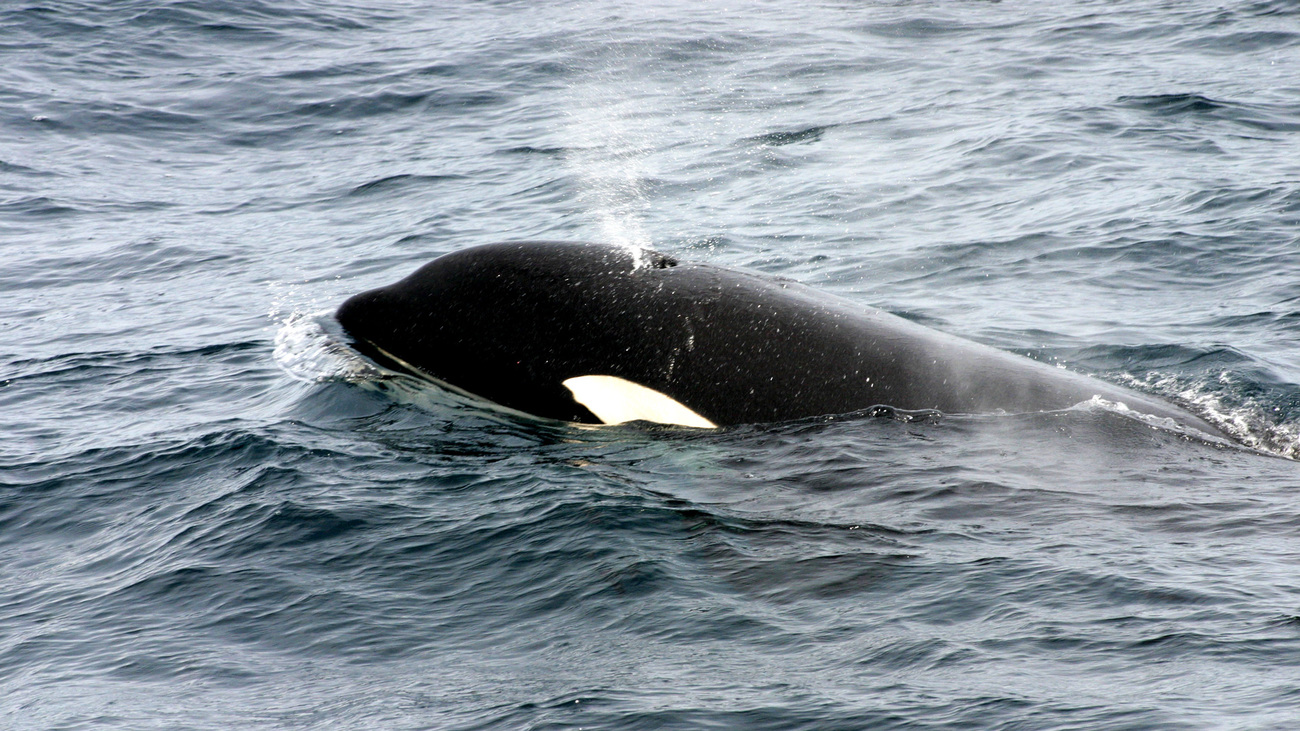
Also known as the killer whale, the orca (Orcinus orca) is one of the most well-recognised whales in the ocean, thanks to their distinct black and white colour patterns. Technically considered the largest dolphin, the orca can grow up to nine metres (32 feet) long and weigh up to 9,980 kilograms (22,000 pounds). Male orcas have a tall, triangular dorsal fin that can reach up to 1.8 metres (5.9 feet) high, while females have smaller, curved dorsal fins.
One of the most well-studied species in the world, orcas are highly intelligent and have complex social structures. They are known to be fierce hunters and have earned the nickname ‘wolves of the sea’.
Beluga whales

The beluga whale (Delphinapterus leucas) is a species of toothed whale that lives in the Arctic and sub-Arctic regions of the Northern Hemisphere. Belugas grow up to 4.5 metres (15 feet) long and weigh up to around 1,500 kilograms (3,300 pounds).
Belugas can be recognised by their uniform white colour, which is how they received their name—beluga translates to ‘white’ in Russian. They have a round head with a bulbous forehead, where their melon organ is located.
As one of the most vocal whale species, belugas received the nickname ‘sea canaries’ by early mariners, who could hear their vocalisations through the hulls of their boats.
Other types of toothed whales include beaked whales and dwarf and pygmy sperm whales.
Animals you might not know are types of whales
Even though these species don’t have ‘whale’ in their names, they’re still considered whales scientifically. Dolphins and narwhals are both types of toothed whales. Their smaller size, different common names, and unique appearances set them apart, but they share many traits with larger toothed whales.
Dolphins
Dolphins are small, toothed whales. Dolphins are found worldwide, living in oceans, seas, as well as freshwater rivers and lakes. There are 40 dolphin species belonging to six different families. Most dolphins are smaller than other whales, growing to around three metres (10 feet) in length. The orca is the largest member of the Delphinidae family, making it the largest dolphin species.
Dolphins are highly intelligent, social animals and are often seen swimming in groups called pods. They use echolocation to hunt and navigate, and some species, like the bottlenose dolphin, are known for playful behaviour.
While all dolphins are whales, not all whales are dolphins. Dolphin species fall under the following family categories:
- Delphinidae (oceanic dolphins)
- Platanistidae (Indian river dolphins)
- Iniidae (New World river dolphins)
- Pontoporiidae (brackish dolphins)
- Lipotidae (Chinese river dolphins)
Dolphins face several threats in the wild, including bycatch, noise pollution, and habitat loss. Some dolphin species are under threat of extinction, including the endangered Indus River dolphin (Platanista minor) and the baiji (Lipotes vexillifer), which hasn’t been spotted since 2002 and may be extinct in the wild.
Narwhals
Narwhals (Monodon monoceros) are small toothed whales that live along coastlines and in rivers in the Arctic. They are often called the ‘unicorns of the sea’ thanks to their long, spiral tusk that grows from the upper jaw of male narwhals. These unique tusks are made out of ivory and begin as a tooth, one of two teeth that narwhals are born with. Usually, it’s the left tooth that grows into a tusk over the course of a male narwhal’s life. It can reach lengths of three and a half metres (9.8 feet). Some female narwhals can grow tusks, and some male narwhals grow two tusks, but both are uncommon occurrences.
Narwhals travel in groups and dive deep to hunt for fish and squid. They use sound to communicate with each other and to navigate their environment.
As of 2025, narwhals are not endangered, but they do face several threats. Because their tusks are made of ivory, narwhals have historically been targeted by hunters as part of the ivory trade. Narwhals are also hunted for food by small Inuit communities in Canada and Greenland. Though hunting narwhals is a tradition in these communities, there is growing concern over declining populations. Narwhals are also threatened by warming temperatures, pollution, and ocean noise.
How can you help protect different types of whales?
All whale species are incredibly important for the health of their ecosystems and the ocean as a whole. They circulate nutrients, feed phytoplankton, store carbon, and help us combat climate change. Without whales, our oceans and planet—and countless animal species—would be in danger.
Unfortunately, deadly threats like ocean noise pollution, plastic pollution, collisions with vessels, whaling, and entanglement in fishing gear continue to push many whale species closer to extinction.
That’s why at IFAW we work around the world to protect whales and their habitats. From rescuing stranded dolphins and porpoises to advocating for slower ship speeds in critical habitats, we’re leading efforts to address the most urgent threats to a wide variety of whale species.
We also work closely to promote responsible whale watching as a sustainable economic alternative to commercial whaling.
Through our marine conservation programmes, we’re working towards long-term solutions to reduce ocean noise, prevent entanglement, and protect endangered whale species.
Sign our petition to help us end commercial whaling in Iceland for good.
Related content
Every problem has a solution, every solution needs support.
The problems we face are urgent, complicated, and resistant to change. Real solutions demand creativity, hard work and involvement from people like you.